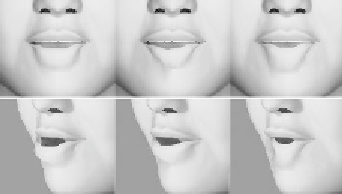Game Development Reference
In-Depth Information
Figure 6. Three lower lip shapes deformed by three of the lower lip parts-
based MUs respectively. The top row is the frontal view and the bottom row
is the side view.
MU Adaptation
The learned MUs are based on the motion capture data of particular subjects.
To use the MUs for other people, they need to be fitted to the new face geometry.
Moreover, the MUs only sample the facial surface motion at the position of the
markers. The movements at other places need to be interpolated. In our
framework, we call this process “MU adaptation.”
Interpolation-based techniques for re-targeting animation to new models, such as
Noh & Neumann (2001), could be used for MU adaptation. Under more
principled guidelines, we design our MU adaptation as a two-step process: (1)
face geometry based MU-fitting; and (2) MU re-sampling. These two steps can
be improved in a systematic way if enough MU sets are collected. For example,
if MU statistics over a large set of different face geometries are available, one
can systematically derive the geometry-to-MU mapping using machine-learning
techniques. On the other hand, if multiple MU sets are available which sample
different positions of the same face, it is possible to combine them to increase the
spatial resolution of MU because markers in MU are usually sparser than face
geometry mesh.
The first step, called “MU fitting,” fits MUs to a face model with different
geometry. We assume that the corresponding positions of the two faces have the
same motion characteristics. Then, the “MU fitting” is done by moving the
markers of the learned MUs to their corresponding positions on the new face.
We interactively build the correspondence of facial feature points shown in
Figure 2(c) via a GUI. Then, warping is used to interpolate the remaining
correspondence.



Search WWH ::

Custom Search